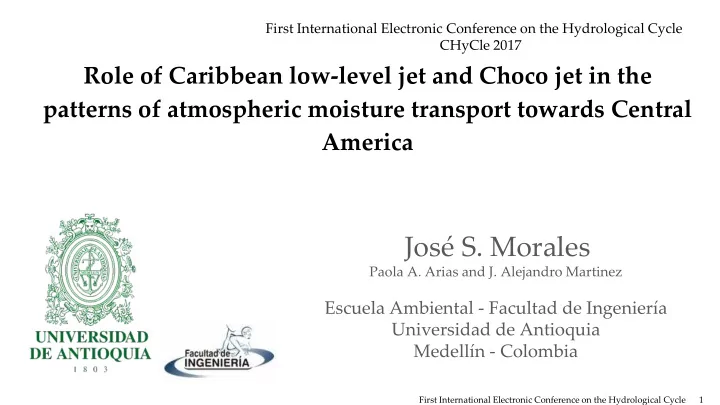

First International Electronic Conference on the Hydrological Cycle CHyCle 2017 Role of Caribbean low-level jet and Choco jet in the patterns of atmospheric moisture transport towards Central America José S. Morales Paola A. Arias and J. Alejandro Martinez Escuela Ambiental - Facultad de Ingeniería Universidad de Antioquia Medellín - Colombia First International Electronic Conference on the Hydrological Cycle 1
Introduction Regional characteristics such Interannual variability as high rate of evaporation Extreme events Development of low-level Large economic losses jets (LLJs)+ topography + associated with other regional factors hydrometeorological phenomena Regional climate Relevant condition to the main economic activities like agriculture First International Electronic Conference on the Hydrological Cycle 2
Objectives General ● To analyze the seasonal patterns of water vapor transport to Central America and their interannual variability, with special emphasis on the role of the Caribbean low-level jet (CLLJ) and the Choco jet (CJ). Specific ● To identify the possible changes observed in the transport patterns from these sources in the face of interannual climate variability events, such as ENSO. First International Electronic Conference on the Hydrological Cycle 3
What has been done before? First International Electronic Conference on the Hydrological Cycle 4
Model Dynamic Recycling Model (DRM): Assumption: Well-mixed atmosphere ● Semi-Lagrangian 2D Model ● Based on the principle of mass conservation ● Used to estimate exchange of moisture from different sources Input Data: Data Set: ● Evaporation ERA-Interim data to 0.75° ● Precipitable Water From 1980 to 2012 ● Precipitation ● Vertical Integrated of Moisture Flux (VIMF) Additional data for analyses: Caribbean low-level jet index (ICLLJ), Choco jet index (ICJ) and Oceanic Niño Index (ONI) First International Electronic Conference on the Hydrological Cycle 5
Study Area SWUS SEUS Figure 1. Region of NATL study. Regions GoM considered as possible moisture sources to Central America CARB domain. The contours TNA TNP represent the topography over the region of study from ERA-Interim data. NAMZ TSP S AMZ TSA LPRB First International Electronic Conference on the Hydrological Cycle 6
Precipitable water climatology DJF MAM DJF MAM JJA SON JJA SON 1 2 3 4 5 6 7 8 9 10 11 12 13 14 15 16 1 2 3 4 5 6 7 8 10 12 13 14 15 16 18 20 Figure 2. Seasonal patterns contributions of precipitable water (mm) for 1980 – 2012 (shaded contours) from CARB (left) and from TNP (right). Vectors represent the VIMF. There is a marked seasonality in the transport form both CARB and TNP to CAM, related to LLJs First International Electronic Conference on the Hydrological Cycle 7
Precipitable water climatology Figure 4. Mean annual cycle of vertical shear of Figure 3. Mean annual cycle of contributions to moisture flux over the analyzed subregions (CARB, precipitable water (W) over the CAM from the main CAM, TNP y GoM). sources (CARB, CAM, TNP, GoM, NOSA and ORIC). Biases associated to high values of the vertical shear of moisture flux (VSMF) in the transport from CARB to CAM and recycling over CAM. First International Electronic Conference on the Hydrological Cycle 8
Interannual variability associated to CLLJ and the CJ August October Figure 5. Correlation between the ICLLJ and moisture transport from Atlantic (a) and CARB (c) for August. Correlation between the ICJ and moisture transport from Atlantic (b) and TNP (d) for October. First International Electronic Conference on the Hydrological Cycle 9
Interannual variability associated to ENSO Figure 6. Composites of differences in moisture transport (mm/day) to CAM during El Niño and La Niña: from the Atlantic (top), the Caribbean (middle) and the TNP (lower panel). The influences of the ENSO evolution is evident in the pattern of moisture transport from these source regions. First International Electronic Conference on the Hydrological Cycle 10
Figure 7. Composites of anomalies of the contribution to monthly precipitable water (mm) over the CAM by CARB (left) and TNP (right) during the extreme phases of ENSO. The plus (minus) sign denotes the positive (negative) phase of ENSO. There is more variability during La Niña phase, and this variability is larger for the transport of moisture from the TNP compared to CARB. First International Electronic Conference on the Hydrological Cycle 11
August (Before) August Figure 8. Composites of differences in VIMF (Vectors) and W (shaded contours, mm) during El Niño and La Niña (Left column). Climatology of VIMF and W (mm) for 1980 – 2012 during August and December, including El Niño, La December (Peak) December Niña and neutral years (right column). Relationship between transport of moisture August (After) from different sources 4 8 12 16 20 24 28 32 36 40 44 48 52 56 during ENSO and the VIMF field. First International Electronic Conference on the Hydrological Cycle 12
Conclusions ● The Caribbean Sea is the largest contributor of moisture to Central America during the year, with an annual variation modulated by the Caribbean low- level jet dynamics. ● Moisture from sources such as northern South America and Gulf of Mexico is relevant for the Central America. Given the period in which they develop their large contribution. ● Despite the biases that present DRM related to the wind shear, DRM is able to capture the interannual variability associated to both low-level jet and ENSO. ● An anomalously strong (weak) Caribbean low-level jet induce a higher (lower) transport from Atlantic to Central America. First International Electronic Conference on the Hydrological Cycle 13
● An anomalously strong Choco jet induces a higher (lower) transport from the Pacific (Atlantic) to Central America during October. ● The transport of moisture from the Atlantic, Caribbean Sea and Tropical North Pacific presents a high response to the annual cycle of evolution of the ENSO. First International Electronic Conference on the Hydrological Cycle 14
Thank you for your attention! jsebastian.morales@udea.edu.co
Recommend
More recommend